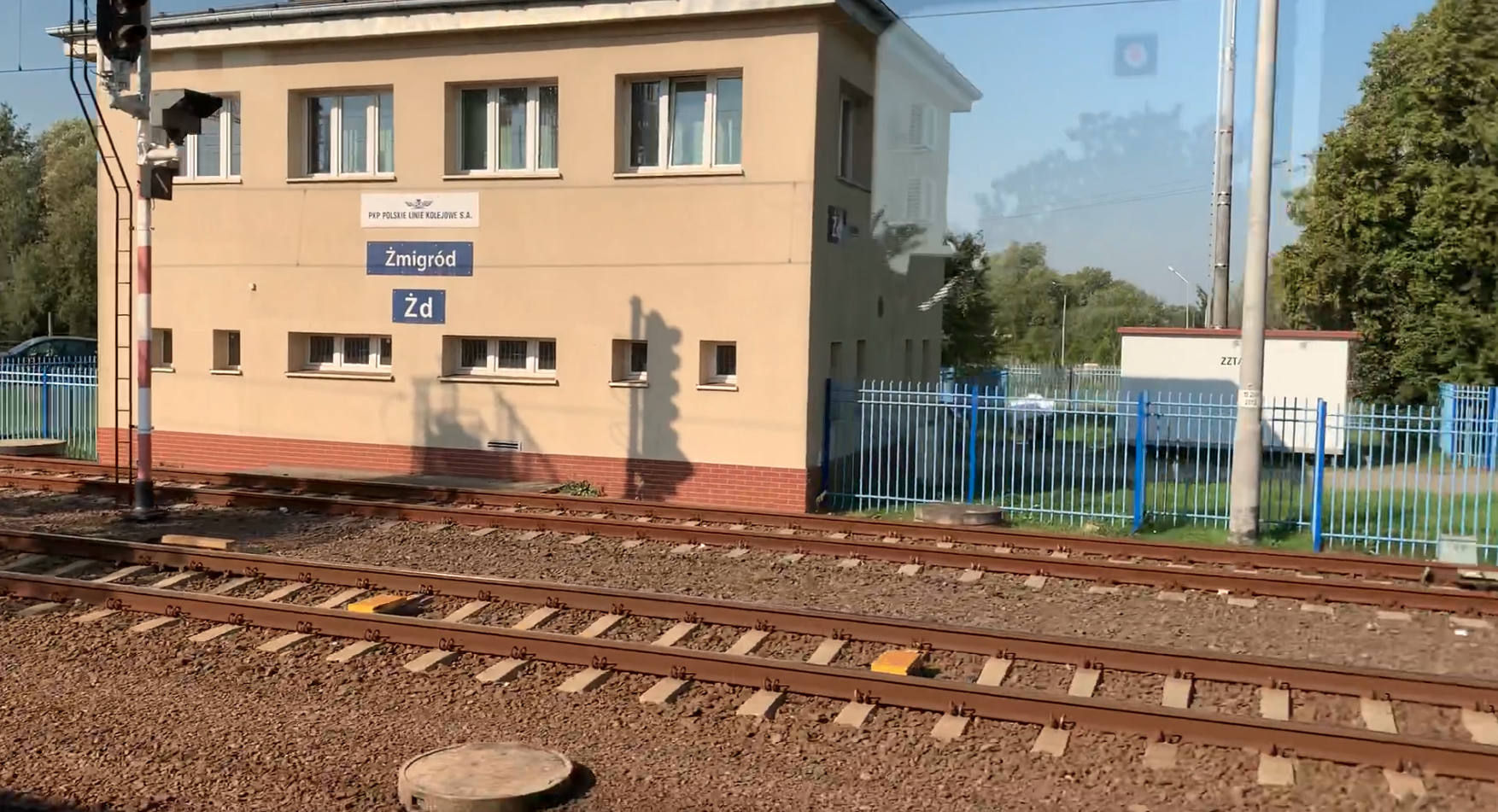Żmigród 2025-05-10
Żmigród railway station.
Geographic coordinates: 51.474N 16.901E. Elevation 89 m.
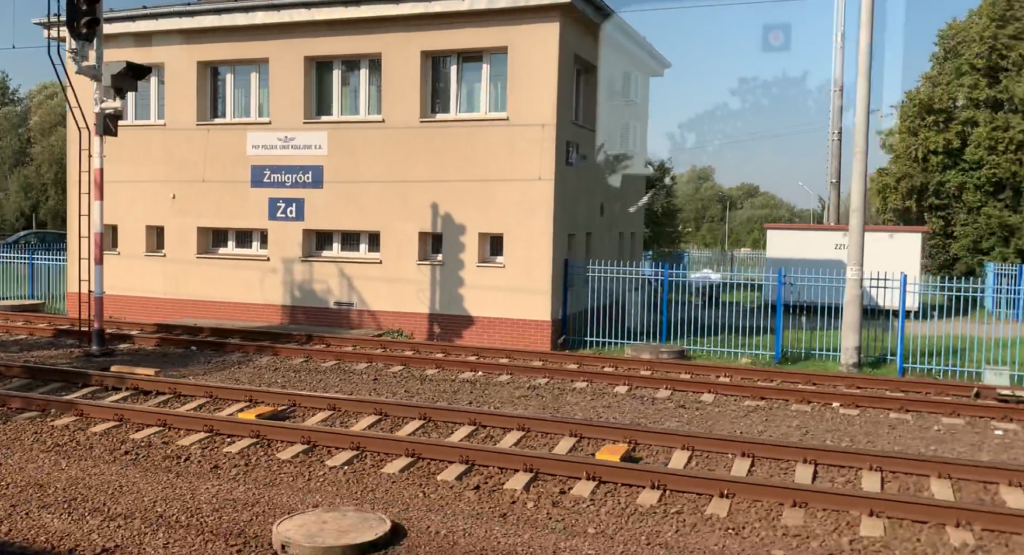
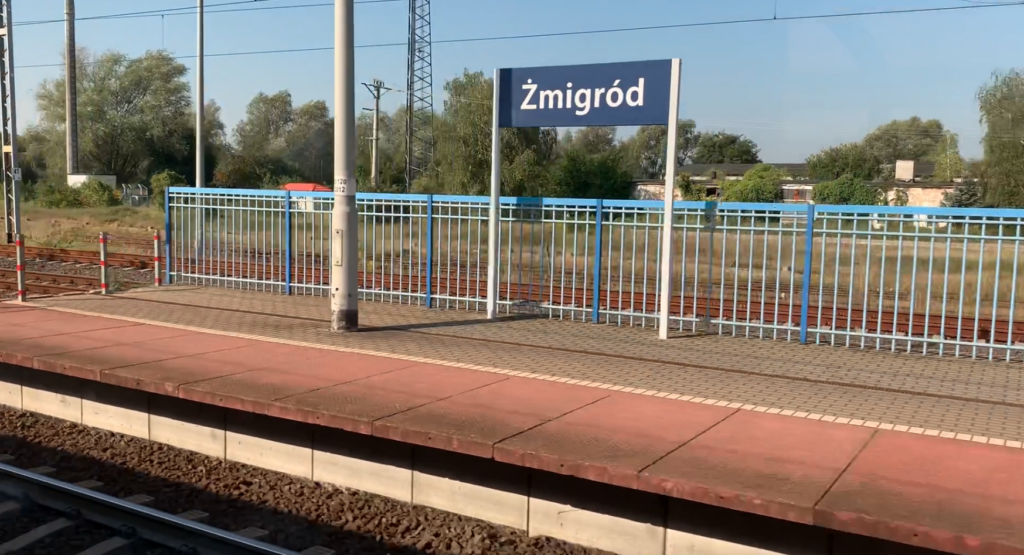
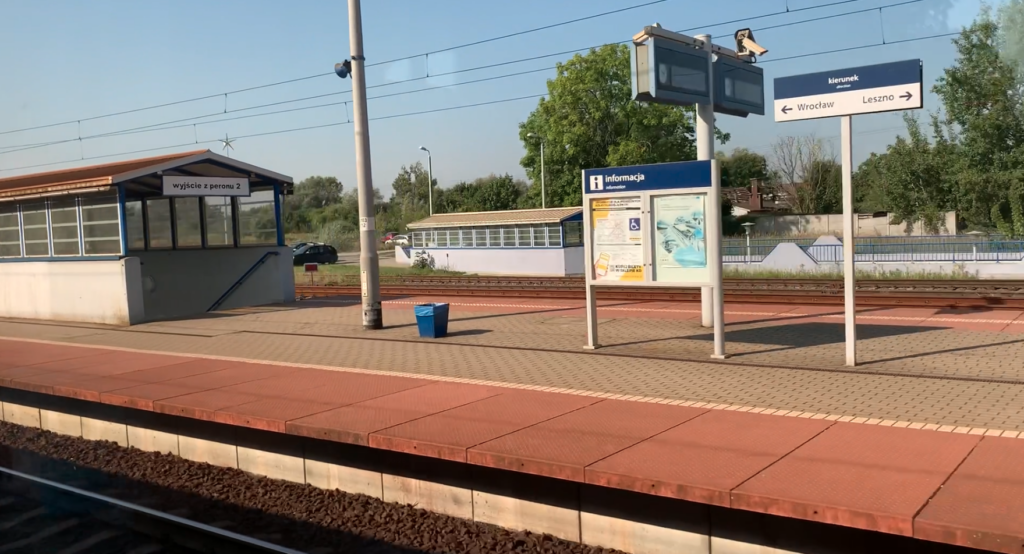
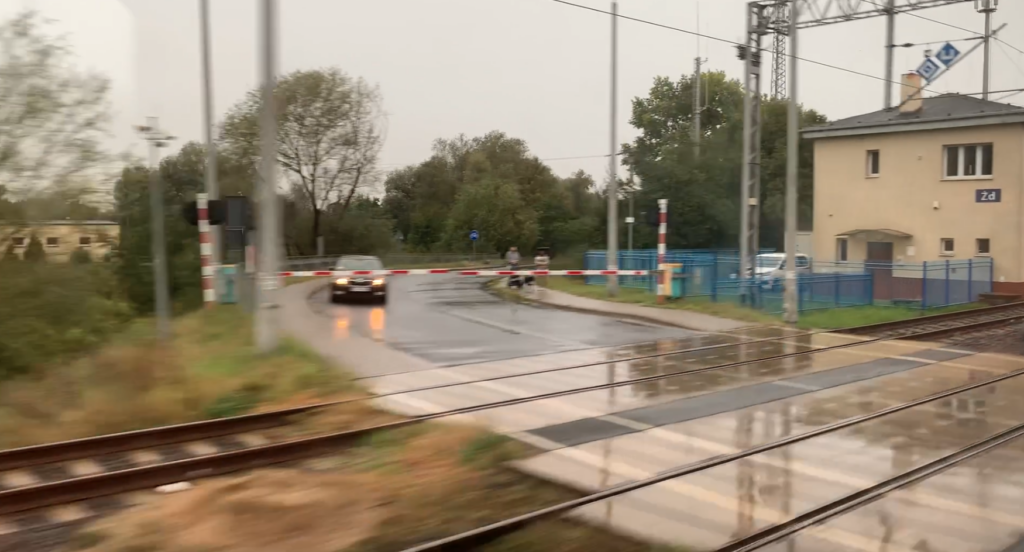
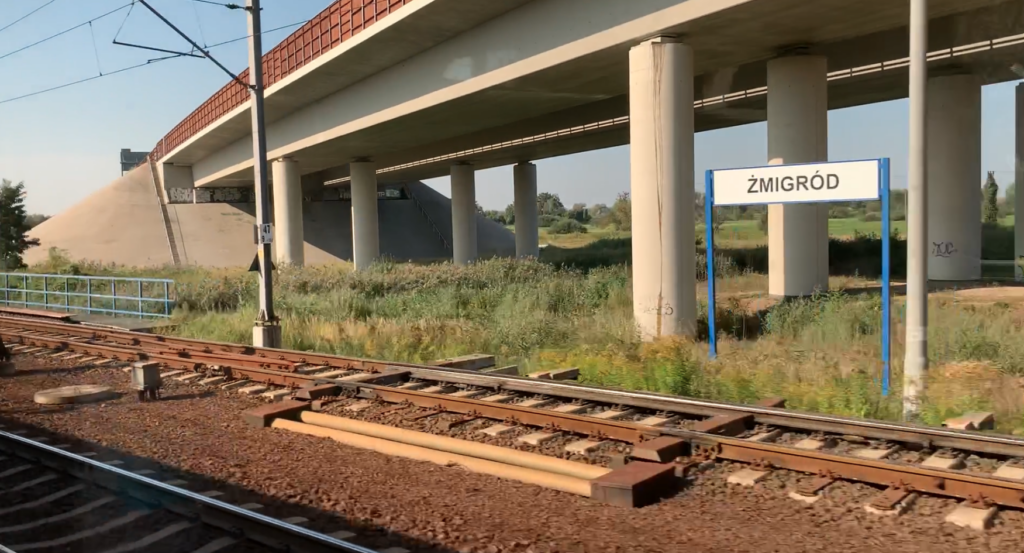
City of Żmigród.
Żmigród is a city located between Wrocław and Leszno, in the Lower Silesian Voivodeship, in the Trzebnica district, on the Barycz (Bartsch), Sowina and Sąsiecznica rivers. The city is the seat of the urban-rural commune of Żmigród. According to data from 2019, the city had 6,435 inhabitants and occupied an area of 9.49 km2. Elevation is 85-103 m. The name “Żmigród” comes from the Old Polish words “żmij” (dragon) and “gród” (castle), which is reflected in the city’s coat of arms. According to other studies, the name Żmigród means “Ringing Castle”, meaning that in case of danger, the bell was rung so that the inhabitants of the castle would take refuge in the castle walls. The old Germanic name is Trachenberg, and the old Polish name is Straburek and Stramburek. The first mentions of the settlement come from 1155, when there was a Slavic settlement called Zunigrod. The main occupation of the population was: beekeeping, fishing, agriculture and smelting of wood tar and bog iron ores. To the north-east of Żmigród and in the central part of the Milicka Basin, for a long time there were only swampy, uninhabited forests. Human settlements appeared there only in the 16th – 18th centuries. In 1253, Duke Henry III the White granted the settlement city rights. The city has witnessed many historical events, including the meeting in 1813 of the Prussian King Frederick William III and the Russian Tsar Alexander I, during which the so-called Żmigród Plan was agreed in the fight against Napoleon Bonaparte. In the 12th century, the stronghold was fortified, surrounded by a palisade, rampart and moat. Two gates were built, which were not removed until 1819. From the south it was the Wrocław Gate, from the north the Polish Gate. In the period 1294-1312 the city belonged to the Duchy of Głogów, and then to the Duchy of Oleśnica. After the line of the Oleśnica princes died out in 1492, the city came under the rule of the Czech King Władysław Jagiellończyk, who two years later sold it, along with the surrounding estates, to Zygmunt Kurzbach. In the mid-17th century, the Polish-Germanic language border ran near Żmigród, south of the city. In Żmigród the Polish language was dominant. The city was destroyed by wars and fires.
On September 1, 1939, the Germans, together with the Muscovites, began World War II and lost a lot. On January 23, 1945, the Soviet 11th Tank Corps of the 4th Tank Army of General Dmitry Lelyushenko occupied Żmigród, which was defended by a Germanic garrison. The city was destroyed, except for the castle, which was set on fire by Stalin’s illiterates after the fighting had ended. The decision of the great of this world, after World War II, Żmigród was incorporated into Poland, and its Germanic population was displaced.
There are numerous monuments in Żmigród, including the ruins of the Hatzfeldt Palace with a residential tower (1656–1658), the church of St. Stanislaus Kostka (1854–1861) and the historic railway station. The market square, the parish church of the Holy Trinity (1599), the water tower, the palace and park complex are all historic. The city is also the gateway to the Barycz Valley, a region known for its natural wealth, including breeding ponds and nature reserves. A significant part of the Żmigród commune is made up of arable fields, forests and fish ponds, with a total area of 1,427 ha. During the PRL period, a number of production plants operated in the city, including a flax retting mill and a branch of the Wrocław PaFaWag. Currently (2025), the city of Żmigród is surrounded on the western side by the S5 motorway, which runs twice over the LK No. 271 railway tracks.
Żmigród railway station.
The railway station in the city of Żmigród was launched in 1856, together with the launch of the Wrocław – Leszno railway line. Initially, the station was called Trachenberg. Żmigród station, together with the entire railway line, was ceremonially opened on October 17, 1865. At that time, the following gathered at the festively decorated station: city authorities, the shooting fraternity, delegates of craft guilds and a large audience. In 1896, a second track was laid on this line. In the large station restaurant there was the so-called Kaisersaal (Imperial Hall). The name comes from the fact that Emperor Wilhelm II often got off his special train in Żmigród to take part in hunting trips with Prince Hatzfeldt. Most of the railway infrastructure buildings that remain today were built in the period 1854-1904, for example the no longer existing water cranes, warehouse, water tower, control room, executive control room (demolished).
The station building was built according to one of the typical designs. The building is made of several blocks. The central part is three-storey, with a projection, and the wings are successively two- and one-storey. On the side of the tracks there is an annex, which housed the control room. The station was built of red brick and is covered with roofs with a slight slope. The building has no separate ornaments, and the windows are rectangular. Currently, the station building houses ticket offices, a waiting room and toilets. The last renovation of the station was carried out in 2012. Currently, the building is plastered and painted in red brick.
Currently, the station has two platforms and three platform edges. The current track layout was created during the renovation of the Railway Line No. 271 Wrocław Główny – Poznań Główny, which was carried out in the period 2012-2016. From Żmigród station there is a connecting track to the experimental track of the Railway Institute, located 4 km west of Żmigród. Access to the platforms is provided by a tunnel, which simultaneously connects the two sides of the city; the eastern and western. The tunnel is accessible to people in wheelchairs, with prams and for cyclists. There has never been a footbridge over the tracks at the station, and the passage was at the level of the tracks. Rail traffic at the station was directed by the “Żd” and “Żd1” signal boxes. Currently, rail traffic is managed by the “Żd” Local Control Center. The water tower stands in the southern part of the station, at the intersection of Wiejska Street and Powstańców Styczniowych Street. In the southern part of the station there is a road-railway intersection along Wiejska Street. Near the station there is a monument commemorating the victims of the train disaster that took place on July 24, 1955. On the station square there are bus stops, a taxi rank and a large parking lot for passenger cars. This is the Żmigród Transfer Center.
Over the past 10 years, the station has served up to 2,100 passengers per day. Passenger traffic is handled by carriers; InterCity, Koleje Dolnośląskie, PolRegio. On May 10, 2025, 71 passenger trains departed from the station. You could go to: Bielsko-Biała Główna, Gdynia Główna, Jelenia Góra, Katowice, Kłodzko Miasto, Kołobrzeg, Kraków Główny, Leszno, Lichkov, Międzylesie, Olsztyn Główny, Poznań Główny, Przemyśl Główny, Rawicz, Szklarska Poręba Górna, Świnoujście, Ustka, Wrocław Główny, Zakopane.
The LK No. 271 Wrocław Główny – Poznań Główny and the former LK No. 317 Żmigród – Wąsosz line run through Żmigród station. LK No. 317 Żmigród – Wąsosz was built in the period 1883-1886. The line was built by the Upper Silesian Railway Company. When the line was put into service, three pairs of trains ran per day. Traffic on it was suspended in 1960. The line was dismantled in 1975, based on the order of the Minister of Communication No. 60 of 9 April 1975. Part of the line infrastructure, in the form of embankments, was used to build a railway experimental track. The Railway Institute’s experimental track is located approximately 4 km from the railway station. The track is of a research and experimental nature, and is primarily used to test the durability and reliability of vehicles, systems, surfaces and railway equipment. The track is the only facility of its type in Poland, one of six operating in Europe and eight in the world. However, NEWAG also has its own experimental track in Poland, 3 km long, which is mainly used for testing electric multi-system vehicles. Additionally, tests of railway vehicles are conducted on a section of the CMK (Central Railway Main Line), mainly speed tests and pantograph operation tests. The construction of the track near Żmigród took a long time. On September 3, 1996, the technical acceptance of the track took place, and on September 12, 1996, its ceremonial opening took place. The track loop is 7,725 meters long, made of straight sections and curves with radii of 600, 700, 800 and 900 meters. The longest straight is 1,314 meters long, and can reach a speed of 160 km/h. This track is mainly used to test different types of surfaces, which is why it was divided into sections on which different types of track bases, fastening structures and other components of the surface were used. The facility allows for testing the durability, reliability, strength, dynamics of devices and systems used on the railway; locomotives, EZT, DMU, wagons and individual systems.
On July 24, 1955 (Sunday), at 1:00 p.m. 17:10 express train No. 9602 from Poznań to Wrocław collided with a shunting locomotive of the Żmigród – Wąsosz train at the station, whose driver, despite warnings and a prohibition from the traffic controller, wanted to enter another track for water before the express train arrived, but did not manage to do so. The driver of the express train from Poznań braked, but a disaster occurred anyway. The locomotive was destroyed, and as a result of the derailment of two carriages behind it, 9 people lost their lives. In addition, 16 people suffered more serious injuries, and almost 50 were slightly injured. All the injured were quickly provided medical assistance by the railway and provincial health services. The military unit that was at the Żmigród station at the time of the accident distinguished itself in the rescue operation.
Written by Karol Placha Hetman
